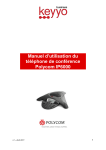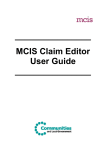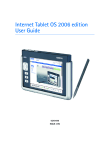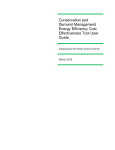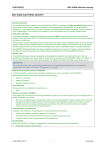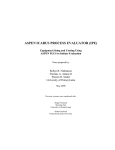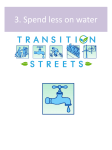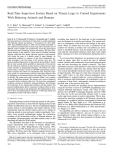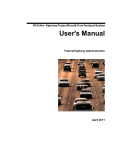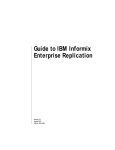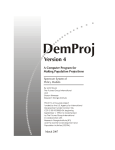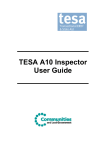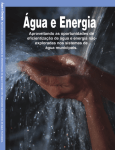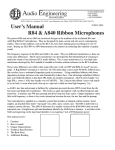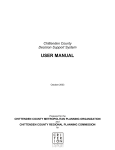Download CE2 Model User Manual - Sustainability Standards 101
Transcript
CE Model 2 User Manual for the Pacific Institute Cost Effectiveness of Water Conservation and Efficiency (CE2) Model Pacific Institute Heather Cooley and Matthew Heberger April 2012 1 User Manual for the Pacific Institute Cost Effectiveness of Water Conservation and Efficiency (CE2) Model April 2012 © Copyright 2012 Pacific Institute All Rights Reserved Pacific Institute 654 13th Street Preservation Park Oakland, California 94612 www.pacinst.org 510.251.1600 Authors: Heather Cooley Matthew Heberger Editor: Nancy Ross Designer: Dana Beigel 2 User Manual Acknowledgements Comments on the model and user manual were provided by (in alphabetical order) Jennifer Burke, Al Dietemann, Kristina Donnelly, Sanjay Gaur, David Koller, Jeannine Larabee, Val Little, Stefanie Olson, Dave Requa, and Gary Wolff. We are grateful for their contributions. The project was supported by the California Department of Water Resources through a grant program funded through Proposition 50. All errors and omissions are, of course, our own. 3 About the Pacific Institute About the Authors The Pacific Institute is one of the world’s leading nonprofit research and policy organizations working to create a healthier planet and sustainable communities. Based in Oakland, California, we conduct interdisciplinary research and partner with stakeholders to produce solutions that advance environmental protection, economic development, and social equity – in California, nationally, and internationally. We work to change policy and find real-world solutions to problems like water shortages, habitat destruction, global warming, and environmental injustice. Heather Cooley Heather Cooley is co-director of the Water Program at the Pacific Institute. Her research addresses the connections between water and energy, sustainable water use and management, and the hydrologic impacts of climate change. Ms. Cooley holds a B.S. in Molecular Environmental Biology and an M.S. in Energy and Resources from the University of California at Berkeley. Since our founding in 1987, the Pacific Institute has become a locus for independent, innovative thinking that cuts across traditional areas of study, helping us make connections and bring opposing groups together. The result is effective, actionable solutions addressing issues in the fields of freshwater resources, climate change, environmental justice, and globalization. More information about the Institute and our staff, directors, funders, and programs can be found at www.pacinst.org. 4 User Manual Matthew G. Heberger Matthew Heberger is a research associate at the Pacific Institute. He is a licensed Professional Engineer, registered as an Environmental Engineer in the Commonwealth of Massachusetts. Mr. Heberger holds a B.S. in Agricultural and Biological Engineering from Cornell University and an M.S. in Water Resources Engineering from Tufts University in Boston. Contents 1. Introduction...............................................................................................................7 2. Model Background...................................................................................................8 3. About the Model....................................................................................................10 3.1 Accessing the Model......................................................................................10 3.2 Minimum System Requirements...................................................................10 3.3 Protected Worksheets....................................................................................10 3.4 Saving Your Work...........................................................................................10 3.5 Sharing Your Information with Other Users..................................................11 4. Getting Started......................................................................................................11 4.1 CE2 Model Overview......................................................................................11 4.2 Enabling Macros.............................................................................................12 4.2.1 Enabling Macros in Excel 2000–2003 (including Office XP) .............13 4.2.2 Enabling Macros in Microsoft Excel 2007 and 2010...........................13 4.3 General Information.......................................................................................14 4.3.1 General Information Worksheet..........................................................14 4.4 Model Inputs...................................................................................................16 4.4.1 Conservation Measures Worksheet.....................................................16 4.4.2 Customer Rates Worksheet.................................................................18 4.4.3 Parameters Worksheet.........................................................................23 4.4.4 Fixed Costs Worksheet........................................................................28 5 4.4.5 Variable Costs Worksheet....................................................................30 4.4.6 Benefits Worksheet...............................................................................32 4.5 Model Outputs...............................................................................................35 4.5.1 Summary Report Worksheet................................................................35 4.5.2 Charts Worksheet.................................................................................39 4.5.3 Cash Flow Diagram Worksheet...........................................................40 4.5.4 Exporting Your Results.........................................................................40 4.6 Sensitivity Analysis..........................................................................................40 5. Conclusion.............................................................................................................42 References....................................................................................................................43 Appendix: Enabling Macros.......................................................................................44 6 User Manual 1. Introduction Over the past 25 years, water conservation and efficiency improvements have provided real water savings, allowing many agencies to maintain or reduce water use while meeting the needs of a growing population and economy. Recent studies indicate that despite the improvements that have already been achieved, significant water conservation potential remains (See Gleick et al. 2003, DWR 2005, DWR 2010). Indeed, legislation passed in 2009 requires California’s urban water agencies to reduce per capita water use by 20% by the year 2020. The economics of water conservation and efficiency are key issues for capturing the water conservation and efficiency potential. In response, a number of groups have developed models to assist agencies in evaluating the cost effectiveness of various water conservation measures (see, for example, California Urban Water Conservation Council 2005; American Water Works Association (undated); and the Alliance for Water Efficiency 2011). The Pacific Institute has developed the Cost Effectiveness of Water Conservation and Efficiency (CE2) Model to help evaluate the economic desirability of water conservation and efficiency measures and explore how costs and benefits can be shared among customers, water utilities, and other entities. The model helps document the costs of starting and running a conservation program and estimate the associated water, energy, and financial savings. The cost-effectiveness of a particular conservation measure varies regionally and according to the level of analysis, e.g., local or state. For example, an irrigation controller giveaway program may be cost-effective in regions where large lawns are common and outdoor use is high. However, it may be less cost-effective in a cooler region with low outdoor water use. In addition, some measures may be cost-effective from a statewide perspective, but not locally. The CE2 Model is sufficiently general and flexible to address these issues because the model outputs are based on conditions defined by the user. The CE2 Model can also help water conservation practitioners share information across departments and with other water, wastewater, and energy utilities. The model quickly and easily calculates financial metrics that are meaningful and readily understood by planners and managers. It also provides a common platform through which to discuss the costs and benefits of water conservation and efficiency. This in turn allows utilities to exchange cost experiences and data and learn from one another more easily. The primary audience for the CE2 Model is water utility staff. The model is appropriate for wholesale and retail utilities of all sizes and can be used by agencies that exclusively provide water services, as well as agencies that also provide wastewater and/or energy services. Additionally, it may be of use to consultants, non-governmental organizations, and others interested in water conservation and efficiency and sustainable management of water resources. 7 2. Model Background The CE2 Model does not provide “the answer” as to whether a particular measure or suite of measures makes economic sense. Rather, it provides a set of financial metrics that can inform the decision-making process. It is important to remember that each metric provides a different view on a body of financial data and has distinct advantages and disadvantages. We recommend evaluating multiple metrics to help determine a particular course of action. Furthermore, it is important to note that economic analyses can be conducted from different perspectives, including the utility, customer, and community/society perspectives. The perspective determines what costs and benefits are included in the analysis. As shown in Table 1, the utility perspective is based on costs and benefits to the water utility. The customer perspective is based on costs and benefits to the customer and can include energy savings, as well as savings from reduced landscape chemical and fertilizer application, less landscape maintenance, and reduced detergent application for dishwashers and washing machines (Gleick et al. 2003). The society perspective is based on costs and benefits to the water utility and its customers and includes all of the factors described above. The society perspective also includes recreational benefits that may accrue to upstream or downstream communities (Vickers 2001). The CE2 Model evaluates the economic efficiency of the water conservation measures from the utility, customer, and the combined (utility + customer) perspectives. The 8 User Manual combined perspective, which evaluates the costs and benefits for the utility and its customers, is narrower than the society perspective in that it does NOT include benefits that may accrue to those outside the utility boundaries, e.g., recreational benefits that may accrue to downstream users from leaving more water in rivers and streams. While it is common practice to evaluate programs exclusively from the utility perspective, we recommend that the utility consider all three perspectives. The utility exists to serve its customers and has no independent value to society. Thus, the perspective of all customers as a group, after the utility has been kept whole through rate adjustments, should be the primary approach to guide decision making. Evaluating measures from multiple perspectives can also provide important information for designing and implementing conservation and efficiency programs. For example, a rebate program that provides $150 for a highefficiency clothes washer may not be cost-effective from the utility perspective. However, it may be highly cost effective from the customer perspective as a result of energy savings and reductions in wastewater costs. As a result, the water agency may consider lowering the rebate level and/ or partnering with an energy provider to offset some of the cost to the water agency. Evaluating measures from multiple perspectives allows the water agency to determine appropriate rebate levels and provides an indication of whether costsharing is appropriate. Table 1 Overview of the Costs and Benefits Included in the Customer, Utility, and Combined Perspectives Customer Utility Combined (Utility + Customer) Costs Customer Program Costs (device, installation, time, etc.) P P Agency Program Costs (administration, labor, surveys, etc.) P Financial Incentives P External Costs (other utilities and their customers, e.g., water, wastewater, electricity) P P P* External Environmental Costs P Benefits Reduced Water and Wastewater Bills P Reduced Energy Bills P Financial Incentives P P P Avoided Supply Costs (capital and O&M) External Benefits (other utilities and their customers, e.g., water, wastewater, electricity) P Environmental Benefits System Reliability P P P* P P P Note: *The CE2 Model allows the user to include environmental benefits in the utility perspective by checking the box on the “Parameters” worksheet. Source: Adapted from Pekelney, Chesnutt, and Hanemann 1996 9 3. About the Model 3.1 Accessing the Model The CE2 Model is free and can be downloaded from the Pacific Institute website at www.pacinst.org. 3.2 Minimum System Requirements The CE2 Model is an Excel spreadsheet with a number of macros to facilitate data entry, calculation, and the display of results. The model can be run in Microsoft Excel 97 or later versions in Windows only. You must also have Microsoft Access installed—as you work, your information will be stored in an Access database file. 3.3 Protected Worksheets The CE2 Model is protected to help avoid data entry errors. You can enter data in blue cells. Cells with a gray background are automatically calculated and should not be changed. If you would like to view hidden worksheets or formulas, you may switch to “Developer Mode” at any time by typing Ctrl + Shift + R. To re-enable “User Mode,” type Ctrl + Shift + U. Note that some cells have a small, red triangle in the upper right-hand corner. If you move your mouse over this cell, a text box will appear that contains additional information about that cell. 3.4 Saving Your Work There is no need to save the CE2 workbook. As you move from worksheet to worksheet within the model, all of the information that you have entered is automatically saved in a separate Access database file. 10 User Manual 3.5 Sharing Your Information with Other Users All of the information you enter into the CE2 model can be shared with other users. If you would like others to view or use the model with your inputs, you will need to provide them with the CE2 Model Excel file and the Access database. The Access database contains your input data. You can e-mail these files to colleagues or place them on a shared server.1 Some email systems, however, do not allow users to receive Access files (.mdb or .accdb). In this case, we recommend compressing the file into an archive file (such as .zip) that can then be sent via e-mail. To create a zip file in Windows, right-click the file and choose “Send to compressed (zipped) archive.” Other free programs for creating zip files can be found online. You can also share the results of your model run (see Section 4.5.4 for instructions on exporting your model results). 4. Getting Started 4.1 CE2 Model Overview Below, we provide a general overview of the steps required to use the model. For additional information on each step, please refer to the sections indicated. 1.Download the CE2 Model from the Pacific Institute website (www.pacinst.org) and save it to your computer or network. 2. If needed, adjust the security settings on Excel to allow macros (see Appendix for instructions). You only need to adjust the security settings one time. 3.Open the CE2 Model and enable macros (see Section 4.2 for instructions). 4. Establish a working database file on the General Information worksheet (see Section 4.3.1 for instructions). All of the information you enter will be automatically saved in the database file you create. 5. Activate the conservation measure(s) and enter the name of the measure(s) you would like to evaluate (see Section 4.4.1 for instructions). 1 Note, however, that the CE² model was not designed to be used by more than one user at a time. 11 6. Enter basic information about the target customer class, including water and wastewater rates, on the Customer Rates worksheet (see Section 4.4.2 for instructions). Add new customer classes, as needed. 7. Enter information about the planning horizon, discount rate, and avoided costs on the Parameters worksheet (see Section 4.4.3 for instructions). 8. For each conservation measure, enter the measure’s fixed costs on the Fixed Costs worksheet (see Section 4.4.4 for instructions). 9. For each conservation measure, enter the measure’s variable costs on the Variable Costs worksheet (see Section 4.4.5 for instructions). 10. For each conservation measure, enter the measure’s benefits on the Benefits worksheet (see Section 4.4.6 for instructions). 11. After you have entered all of the required information, the “Input Completed” cell on the Conservation Measures worksheet will read “100%.” Then, click the “Calculate” button at the top of the screen, and review the model output (see Section 4.5 for instructions). 4.2 Enabling Macros This workbook contains custom Visual Basic for Applications (VBA) macros. Many Excel users, however, have default security settings that do not allow macros. In order to use the CE2 Model, you must change Excel’s security settings to give you the option to enable macros when you open the workbook. Detailed instructions for changing the security settings can be found in the Appendix. You will only need to change the security settings once.2 Once you have changed Excel’s security settings, you can enable the macros by following the procedure on the following page. Note that the procedure is different for users of Microsoft Excel 2007–2010 and for Excel 2000–2003. 2 12 Note that you can allow all macros to run without warning, but this could expose you to malicious code and is not recommended for most users. User Manual 4.2.1 Enabling Macros in Microsoft Excel 2000–2003 (including Office XP) 1.Download the CE2 Model to your computer. Open the CE2 Model Excel file. 2. A pop-up dialog box will appear. 3. Click the button to enable macros. You will need to repeat this step every time you open the CE2 Model. 4.2.2 Enabling Macros in Microsoft Excel 2007 and 2010 1.Download the CE2 Model to your computer. Open the CE2 Excel file. 2. A message bar will appear near the top of the Excel window, titled “Security Warning.” Click the “Options…” button, which is indicated by the red circle in Figure 1. 3. In the “Microsoft Office Security Options” window, choose “Enable this content” and click OK. You will need to do this step every time you open the CE2 Model. Figure 1 Security Warning Panel 13 4.3 General Information 4.3.1 General Information Worksheet All of the data file management tasks are located on the General Information worksheet (Figure 2). To begin, you must create an Access database file. Create a new, empty file by selecting “Create a New File.” Specify a file name and location and click “Save.” The default location is the same folder where the CE2 Model Excel file is saved. However, you are free to save this file anywhere on your computer or local network, including mapped network drives or a UNC path.3 Be careful not to move or delete this file while using the model. The program will set this new file as the current working database. Each time you navigate from one sheet to another, your responses will be saved automatically in the Access database file. To continue working with a previously created file, click “Open an Existing File” and navigate to the appropriate Access database (.mdb) file. The General Information worksheet contains other features that may be useful. Each feature is described below: • From time to time, you may wish to make a backup of your current data file to return to a particular set of inputs at a later time. Click “Backup a Copy of the Current File” to make a copy of your active database file and change its extension from .mdb to .bak. If you wish to work with this file again, you must first change the file name so that the extension is .mdb and then click “Open an Existing File.” • To verify that the database file shown is valid, click “Check Database Connection.” • To view the file location in Windows Explorer, click “View Folder.” • If you’ve been using the same database for a long time, its file size can increase. Clicking “Compact Database” from time to time will keep the file size down. 3 14 Using a network folder which has been mapped to a drive letter (Z:) is preferable to using a UNC path (\\server23\office\files\). User Manual Figure 2 General Information Worksheet Agency Type On the General Information worksheet, the CE2 Model prompts you to identify whether the agency provides water, wastewater, and/or energy services. Your response will determine which benefits of conserving water accrue to the agency and are included in the cost-benefit analysis from the agency perspective. For example, implementing a high-efficiency toilet retrofit program reduces water demand and wastewater flow. The program can calculate 15 avoided costs of wastewater treatment associated with reduced wastewater flows. This benefit will accrue to your agency only if you indicated that it provides wastewater service. Otherwise, it will be included as a benefit in the “Combined Perspective.” 4.4 Model Inputs To conduct a financial analysis of a water-saving measure, you will need to enter a number of values and parameters into the CE2 Model. Many of these inputs will be specific to your agency or your region, such as labor costs or water rates paid by your customers. The model includes default values for some inputs to help you get started; these are not necessarily typical or representative. We encourage you to use your own data or data from other reputable sources. Once you have enabled macros and established a working database, proceed to the Conservation Measures worksheet to enter information about the conservation measures you would like to evaluate. From this worksheet, you can then link to five worksheets that contain additional user inputs. Information on two of the worksheets applies to all conservation measures under consideration: (1) Customer Rates and (2) Parameters, which include discount rates and avoided supply costs. For each water conservation measure, you must enter information on the (3) Fixed Costs for implementing the measure; (4) Variable Costs for implementing the measure; and (5) information on the water and energy Benefits of the measure. A description of these terms and the input variables are provided in the following section. 4.4.1 Conservation Measures Worksheet The Conservation Measures worksheet (Figure 3) is the central worksheet within the model. All input worksheets can be accessed from here. Follow the procedure below to get started: 1. Activate the conservation measure by clicking the “Turn On/Off” button. A checkmark will appear in the box and the input buttons associated with that measure will turn from gray to blue. 2. Enter the name of the conservation measure you wish to evaluate. 3. To enter input data, click on each of the blue boxes, e.g., Fixed Costs and Variable Costs. This will take you to another worksheet where you will be prompted to enter input data. Once you have finished entering the required 16 User Manual information on each of the input worksheets, select “Save” to return to the Conservation Measures worksheet. A checkbox will appear in the box to indicate that the input worksheet is complete. 4. Repeat steps 1 through 4 for each conservation measure you would like to evaluate. Once you have entered all of the required information, return to the Conservation Measures worksheet. The “Input Completed” cell will read “100%.” Click the “Calculate” button at the top of the screen to review the model outputs. Figure 3 Conservation Measures Worksheet 17 4.4.2 Customer Rates Worksheet The Customer Rates worksheet (Figure 4) contains inputs that apply to every conservation measure under consideration. Here, you enter the rates customers pay for water, wastewater, electricity, and natural gas. These inputs are especially important for evaluating the water conservation measure from the customer perspective. Customer Classes Each conservation measure can be designed to target a particular customer class. In the Customer Rates table, you can enter information for up to six customer classes. We have provided defaults such as “Residential, Single Family” and “Commercial.” You can, however, create any type of customer class. For instance, you may want to create a broad category called “Residential” that covers both single-family and multi-family customers. You also might want to create specific customer classes in order to be able to calculate the effect of targeted programs on, for example, “Elementary Schools” or “Laundromats.” Utility Rates Enter the rates paid for water, wastewater, etc. for each customer class under consideration. The rates entered should reflect what the customer pays for each additional unit of water, i.e., the marginal rate. In other words, it should exclude fixed costs such as connection fees, etc. If customers pay only a fixed fee for water or wastewater (e.g., a flat rate rather than a volumetric rate), then the customer’s bill will not change as a result of changes in water use. Thus, the marginal rate, and the rate that should be entered in the rate column, is $0. You will be prompted to enter the percentage of people with gas and electric water heaters. This information is used to calculate the savings from energy reductions associated with water conservation and efficiency measures and factors into the customer and combined perspective financial metrics. A 1997 study estimates that the national market share for water heater fuel types is approximately 54% natural gas, 38% electric, 5% oil, and 3% liquefied petroleum gas (LPG) (Wenzel 1997). While the information is somewhat dated, it may be useful in the absence of more detailed information for your region. 18 User Manual Figure 4 Customer Rates Worksheet 19 Tiered Rates Increasingly, agencies are adopting tiered, or block, rates. Because the marginal cost of water (or wastewater or energy) will vary depending on the tier that the customer is in, the potential economic savings to the customer will also vary. If by reducing water use, however, the customer shifts to the lower tier, then the marginal cost of water may vary. For example, let’s say that a customer is in the third tier and is paying $5 per thousand gallons of water. The customer installs a high-efficiency clothes washer and reduces household water use such that the customer is now in the second tier, where the marginal cost of water is $3 per thousand gallons of water. In this example, there are two marginal costs: $3 and $5 per thousand gallons of water. Thus with tiered rates, determining the correct marginal rate can be quite complicated. To simplify this analysis, the CE2 Model calculates the marginal rate for the typical customer and the average of all marginal rates and allows you to choose among the two options. The average marginal rate is the more conservative choice and will ultimately make the conservation investment look less favorable from the customer’s perspective. The Tiered Rates worksheet is provided only as an expedient way to calculate an average and/or marginal rate for each customer class. If the water conservation measure is targeted toward those in high tiers, however, you may choose to enter the marginal rate for customers in that tier. To calculate these rates, use the Tiered Rates worksheet (Figure 5), which you can access by clicking “Enter Block or Tiered Rates” on the Customer Rates worksheet. Once there, follow the procedure below. 1. Choose the customer class from the drop-down list. This list will contain the customer classes entered on the Customer Rates worksheet. If the target customer class is not visible, check that the information was correctly entered on the Customer Rates worksheet. 2. Next, enter the commodity for which you are entering the tiered rate information, i.e., water, wastewater, electricity, or natural gas. Select the appropriate units for the commodity. 3. Enter the average use for the target customer. 4. Enter the tiered rates. The left column is the lower threshold for the tier, or the lower bound at which the rate begins. The first lower bound is zero and cannot be changed. Enter the rate for consumption at that tier on the right. The chart at right will help you visualize the tiers and ensure that values are entered correctly. 20 User Manual 5. Based on this information, the model calculates the average and marginal rates. These are displayed at the bottom. Choose which you would prefer to use in this analysis. Take a moment to verify that this result is reasonable and the units are correct. 6. Click “Save.” The rate will automatically be entered on the Customer Rates worksheet under the appropriate customer class. 7. Repeat steps 1-7 for each customer class you wish to include in your analysis. 8.Once you have entered information for all of the customer classes of interest and you have returned to the Customer Rates worksheet, click “Save” to return to the Conservation Measures worksheet. Figure 5 Tiered Rates Worksheet 21 Escalation Rates Water and energy rates in many areas are currently increasing faster than the rate of inflation. As prices rise, the investment in water conservation and efficiency becomes more financially favorable. Here, you can enter annual escalation rates for water, wastewater, electricity, and natural gas, i.e., the annual percent change in the price that the customer pays for these services. The escalation rate can be positive or negative, depending on whether rates are increasing or decreasing, respectively. The escalation rates entered here affect the financial analysis from the customer perspective only. Annual escalation rates for water and wastewater may be available from your financial department. For energy-related escalation rates, consider using estimates generated by a reputable source, such as your energy provider, the U.S. Energy Information Administration, or the California Energy Commission. The escalation rates will be applied over the planning horizon you enter on the Parameters worksheet (see Section 4.4.3 for information on the planning horizon). Remember that these escalation rates are associated with the price that the customer pays for water, wastewater, and energy. Separate escalation rates are included for water and energy utility avoided costs on the Parameters worksheet. An escalation rate can be either real or nominal. The real escalation rate is the rate without inflation. The nominal escalation rate, by contrast, is the real escalation rate plus inflation. For example, let’s say we expect water rates to rise by 1.5% per year due to a major capital improvement program and higher operation and maintenance costs. Additionally, inflation is occurring at about 1% per year. Here, the real escalation rate is 1.5%, and the nominal escalation rate is 2.5%. The CE2 Model allows you to enter whichever value you choose. It is important that you choose either the real (adjusted for inflation) or nominal (not adjusted for inflation) rates for both the escalation rates and for the discount rate, described below—not a mix of the two. Note that the inclusion of escalation rates is optional; if you do not wish to include rising commodity prices, enter “0%” as the real escalation rate. By entering “0%,” however, you are assuming that the real price that the customer pays for water, wastewater, and energy will remain constant over time, which is unlikely given recent trends. If you are using nominal discount rates throughout the model, then you must use the nominal escalation rate. So even if the real rate is not increasing, the nominal rate would include some estimate of inflation. 22 User Manual 4.4.3 Parameters Worksheet The Parameters worksheet (Figure 6) contains inputs that apply to all of the conservation measures under consideration. Each input is described in greater detail on the following pages. Figure 6 Parameters Worksheet 23 Planning Horizon The planning horizon is the time period over which the model will evaluate the conservation measure’s costs and benefits. You can enter a value ranging from 1 to 99 years for the planning horizon. A horizon of 30 years is typical for planning capital projects and is a good choice if you are trying to compare a conservation program on an equal footing with infrastructure projects. You may also try a planning horizon equal to the expected lifetime of a water-saving device, if you want to evaluate the savings that will occur over the course of its use. This becomes more complicated, however, when comparing alternatives with different lifetimes. In order to capture all of the costs and benefits that occur over the course of the program, however, the planning horizon (on the Parameters worksheet) must be longer than the program duration. The planning horizon will have a major effect on the financial metrics output by the model. You are encouraged to try changing the planning horizon and re-running to model to compare the results. A more detailed discussion of this is provided in the FAQs, which are available online at www.pacinst.org. Note that the planning horizon is different than the device lifetime or the program duration. The device lifetime is the length time that the efficient device is expected to remain functional. A clothes washer, for example, has an average lifetime of 12 years, and a toilet has a lifetime of 25 years. The program duration is the number of years that a conservation program will be offered. A utility may offer 2,000 rebates for clothes washers for each of 5 years, for a total of 10,000 rebates. In this example, the program duration is 5 years. You should specify the device lifetime on the Benefits worksheet and program duration on the Variable Costs worksheet. Annual Discount Rate Water conservation and efficiency measures typically require an initial cost, while the benefits accrue in the future over the lifetime of the device. Because a dollar today has a different value than it will in five years from now, future costs and benefits are discounted, or converted into their present value. This conversion is based on the discount rate, which is also referred to as the cost of capital. The discount rate has a large effect on the analysis. While no defaults are provided, economists typically use a discount rate that ranges from 0 to 10%. Note that today’s rates are significantly lower than those offered during the 1990s, and future rates are uncertain. You are encouraged to experiment with different discount rates within a reasonable range to understand the sensitivity of the analysis to this important parameter. 24 User Manual Like the escalation rate, the discount rate can be either real or nominal. The real discount rate is the rate without inflation. The nominal discount rate, by contrast, is the real discount rate plus inflation. The CE2 Model allows you to enter whichever value you choose. It is important that you choose either the real (adjusted for inflation) or nominal (not adjusted for inflation) rates for both the escalation rates and for the discount rate, described below—not a mix of the two. Avoided Costs Avoided costs are the savings associated with not having to produce a unit of water. Avoided costs have both fixed costs, associated with adding capacity, and a variable component, associated with operations and maintenance (O&M). By conserving water, a utility reduces its O&M cost, especially its chemical and energy use for extraction, conveyance, treatment, distribution, and wastewater treatment. The economic value of these reductions is typically referred to as avoided marginal operation and maintenance cost or short-run marginal cost. Conserving water can also reduce, defer, or eliminate new water, wastewater, and energy infrastructure investments. The economic value of these savings is typically referred to as avoided marginal capacity cost. The long-run marginal cost is equal to the short-run marginal cost plus the marginal capacity cost. You can specify values for avoided marginal capital cost and operation and maintenance costs for water, wastewater, natural gas, and electricity. These values are unique to the agency and can usually be obtained from the utility financing department. Other potential sources for information on water and wastewater costs include the California Urban Water Conservation Council (CUWCC) Avoided Cost Model (CUWCC 2006).1 You may also wish to enter energy-related avoided costs for natural gas and electricity. These parameters will affect the results if any of your planned conservation measures result in energy savings. If your agency sells energy in addition to water, energy savings by your customers can also represent an important savings from the avoided cost of having to build new infrastructure to meet growing or future energy demands. If your agency does not sell gas or electricity, these parameters will affect the results that are reported from the combined perspective. Although the costs or savings do not accrue to your agency, they will affect other utilities, which are included in the combined perspective. If you do not wish to include these avoided costs, then enter “0” in the avoided cost for electricity and natural gas. 1 The CUWCC Avoided Cost Model can be accessed from the CUWCC website at www.cuwcc.org. 25 Environmental Benefits Ecosystems provide a variety of goods and services, including flood protection, water purification, wildlife habitat, and recreational opportunities. While there are rarely any direct market values for these services, there is a growing recognition that these services have an economic value and should be included in decision-making processes. The CE2 Model allows you to integrate environmental benefits into the economic analysis of water conservation and efficiency measures. You have the option of including environmental benefits in the agency or combined perspective. Your response to the question “Environmental benefits accrue to agency?” will affect whether the agency receives a monetary credit for environmental improvement. Choosing “Yes” will mean that environmental benefits will be included as a positive cash flow to the water agency. This will affect the financial metrics in the “Agency Perspective” report, making programs more favorable. If you choose “No,” environmental benefits are included only in the “Combined Perspective” report. There is no single accepted methodology for estimating ecosystem values. The available methods can be grouped into three categories: direct, indirect, and proxy. Each of these methods has strengths and weaknesses; each fails to fully capture the value of ecosystems. The unacceptable alternative, however, is to assign an economic value of $0—clearly acknowledged to be wrong. To put it simply: “We don’t protect what we don’t value” (Myers and Reichert 1997). Users in California may wish to use the CUWCC Environmental Benefits Model to develop this estimate.2 Other users are encouraged to explore this model, as well as other data sources. Table 2 lists typical environmental benefits associated with water conservation and efficiency. Avoided Cost Escalation Rate Here, we allow you to enter annual escalation rates for O&M and capacity costs for water, wastewater, electricity, and natural gas. The cost of operating, maintaining, and building new infrastructure changes over time in response to a variety of factors, including changes in the price of the raw materials needed to maintain and build these facilities. This change is captured in the escalation rate. Note that the escalation rate can be positive or negative, depending on whether the utility avoided costs are increasing or decreasing, respectively. Be consistent throughout in using either real (adjusted for inflation) or nominal (not adjusted for inflation) escalation rates. 2 26 The Environmental Benefits Model can be accessed from the CUWCC website at www.cuwcc.org. User Manual Escalation rates for water and wastewater vary considerably among water and wastewater utilities. Contact the financial department at your local water and wastewater service provider to estimate escalation rates appropriate for your service area. Similarly, electricity and natural gas escalation prices may be available from the energy utility or from either the U.S. Energy Information Administration or the California Energy Commission.3 Note that the inclusion of escalation rates is optional. However, if you have been using nominal values for the escalation and discount rates throughout the model, your avoided cost escalation rate must account for inflation. Table 2 Typical External Environmental Benefits of Conservation Rivers/Lakes Coastal/Estuarine Fish populations, including their migration routes and spawning areas Maintenance of freshwater and nutrient inflows Riparian vegetation and wildlife Marshlands Marshland vegetation, eelgrass, mangroves Reduced salt water intrusion Wildlife and birds Recreational benefits of maintaining instream flows Fish populations Groundwater Fewer low water tables Reduced land subsidence Reduced contamination from salt water intrusion Baseflow to rivers and streams Dilution of pollutants Avoidance of regulatory actions Maintenance of downstream water rights Source: Adapted from Pekelney et al. 1996 3 See, for example, the Energy Escalation Rate Calculator at http://www1.eere.energy.gov/femp/information/download_blcc.html#eerc. 27 4.4.4 Fixed Costs Worksheet The Fixed Costs worksheet contains fixed costs that occur at start-up or that are independent of the number of devices offered (Figure 7). These inputs must be entered for each conservation measure under consideration and are described in greater detail below. Note that the model has an “Import” feature that allows you to import values from previously entered conservation measures. Up-front Costs Up-front costs are those costs that are incurred before the program begins. These start-up expenses may include program planning and design, fees to consultants or other outside planning assistance, or any other costs that occur once. Up-front costs do not include money spent to purchase capital or any sort of durable goods. They also do not include costs to implement the project, such as advertising costs. Program Duration Program duration is the length of time that the conservation program will be funded and implemented by the agency. For example, a toilet rebate program may last for five years, with a planned number of rebates provided each year. Note that the program duration is different from the device lifetime, which is how long the toilet is expected to function, and the planning horizon, which is the time period over which the model will evaluate costs and benefits. In order to capture all of the costs and benefits that occur over the course of the program, the planning horizon (on the Parameters worksheet) should be longer than the program duration. 28 User Manual Figure 7 Fixed Costs Worksheet Annual Fixed Costs Annual fixed costs are those costs that occur every year and are independent of the number of units that are installed or distributed. The cost of radio ads to publicize a toilet rebate program, for example, is independent of the number of rebates you provide. Annual fixed costs can include administrative, publicity, evaluation, and follow-up costs as well as fees paid to an outside consultant. Variable costs, by contrast, depend on the number of rebates provided and should be included on the Variable Cost worksheet. Some of the fixed costs may be defrayed by an outside source, such as by a grant or contribution from an energy or wastewater utility. You can enter the amount received from an outside source in the field labeled “Outside funding sources.” 29 4.4.5 Variable Costs Worksheet Program expenses that depend on the number of units offered should be entered on the Variable Costs worksheet (Figure 8). On this worksheet, you will enter costs borne by the customer and those borne by the utility. These inputs must be entered for each conservation measure under consideration and are described in greater detail below. Program Type You should select the type of program under consideration. Three program types are available to choose from: a rebate, direct-install, or a giveaway program. Rebate programs are those where the utility provides the customer with a rebate or some other incentive, such as a credit on their water bill, to cover a portion of the cost. With direct-install programs, the utility purchases and installs the device. The utility may bear the entire cost of the device and installation or may seek compensation through a single or monthly payment on the customer’s water bill. With a giveaway program, the utility bears the cost of the device while the customer bears the installation cost. Number of Units Each Year In this field, specify the number of units that are provided to customers each year. With a faucet aerator giveaway program, for example, you should specify the number of aerators that will be given away each year. For a multi-year program, you can enter the same number of units for each year by choosing “Same each year” from the drop-down menu. To vary the number of units available each year, choose “Varies by year” from the drop down menu. This is useful, for example, if you plan to ramp up a program over time. Next click on the now-active “Edit Number of Units” to bring up a new worksheet that asks you to specify how many units will be given out each year. Click “Save” to return to the Variable Costs worksheet. Agency Costs Utility costs include cost of the device and any installation and maintenance costs. If it is a typical rebate program, then the utility’s variable costs would include the amount of the rebate. Direct install programs would include the cost of the device plus any installation and maintenance costs. 30 User Manual Figure 8 Variable Costs Worksheet Customer Costs Customer costs include the capital, installation, and maintenance cost of an efficient and standard device. Based on information input by the user, the model calculates the incremental capital, installation, and maintenance costs associated with the efficient device—that is, the cost is compared to a conventional, non-conserving alternative. Operation and maintenance costs can 31 include detergent costs in the case of clothes washers and dishwashers, or mowing and chemical costs for landscapes. Note that savings from reductions in wastewater and energy savings are included in the Benefits worksheet and should not be included here. Units Installed All of the conservation devices distributed to customers may not actually be installed. The default value for this parameter is 100%, meaning that 100% of the devices are installed. For a direct install program, this may be accurate. For giveaway programs, the percent of units actually installed may be lower. Ideally, follow-up monitoring would be conducted to estimate this parameter. The percent of units installed ultimately affects the economic desirability of a water conservation measure because the water utility pays the incentive cost but does not capture the benefit. Free Riders A free rider is defined as a customer that takes advantage of a water conservation and efficiency program but that would have installed the conserving device anyway, without additional financial assistance. The default value for this parameter is 0%, although you may adjust this value as needed. Free riders affect the economic desirability of a water conservation program. While an agency that spends money on a free rider incurs the cost of the incentive, it does not get credit for the water savings because they would have occurred without the incentive. While not everyone agrees on the importance or significance of this concept, we include it here for those that wish to use it. 4.4.6 Benefits Worksheet The Benefits worksheet contains inputs that must be entered for each conservation measure under consideration (Figure 9). Additional information on each input is provided below. Target Customer Class For each conservation measure, you must specify the target customer class. General categories are provided, although you can create custom customer classes. The custom classes must first be created on the Customer Rates worksheet. Once created 32 User Manual and saved, they will appear in the dropdown box on the Benefits worksheet. If you want to enter a conservation measure for many customer classes, you will need to enter the information for each class as a separate conservation measure (here the “import data” function will be particularly helpful). Figure 9 Benefits Worksheet 33 Lifetime of Device The device lifetime is the length of time that the efficient device is expected to remain functional. A clothes washer, for example, has an average lifetime of 12 years, and a toilet has a lifetime of 25 years. Note that the device lifetime is distinct from the program duration or the planning horizon. For the purposes of this model, we assume that devices are replaced with the same device when they wear out and the cost of replacement is borne by the customer. Water and Energy Savings These fields are where you enter the estimated water savings associated with the conservation measure under consideration. If a water-saving device results in changes in energy use, you should enter that here, too. For the energy savings, enter the amount of gas saved by a household with a gas water heater AND the amount of energy saved by a household with an electric water heater. The model will allocate the energy savings based on the percent of each customer class using gas versus electric on the Customer Rates sheet. In some cases, a water-saving device may increase electricity use (e.g., hot-water recirculating systems in homes with gas water heaters). In this case, enter a negative number. For example, entering “-100 kWh/year” means the device consumes 100 kWh per year more than its conventional alternative. Defaults are not provided for water and energy savings. You can obtain this information from a variety of sources, including research reports, product manufacturers, U.S. EPA EnergyStar or WaterSense analyses, and agency-sponsored studies. Additionally, the Pacific Institute’s WECalc model, available online at www.wecalc.org, may be a useful tool for estimating the energy savings of water conservation and efficiency measures for a single household. Outdoor Water Savings You are prompted to identify whether the conservation measure reduces indoor or outdoor water use. Water used outdoors typically evaporates or is discharged to a storm drain. Therefore, reducing outdoor water use does not reduce wastewater treatment costs. Conserving water that is used indoors, however, saves on wastewater treatment costs. This information is needed to determine whether avoided wastewater costs and reduction in customer wastewater bills should be included in the economic analysis. 34 User Manual 4.5 Model Outputs You are now ready to do the analysis. Click “Calculate (next)” on the Conservation Measures worksheet to run the model. The outputs from the CE2 Model include a series of summary reports, charts, and cash flow diagrams. Click on the icons at the top of the page to view the various outputs. 4.5.1 Summary Report Worksheet The Summary Report worksheet contains an estimate of the volume of water and wastewater conserved as well as a variety of financial metrics to help decide which conservation and efficiency measures are feasible and financially desirable. These financial metrics are evaluated from the utility, customer, and combined perspectives. You can view the summary reports for each of the perspectives by clicking on the blue hyperlinks at the top of the page (Figure 10). The customer perspective gives you the perspective of an individual customer, rather than being representative of the entire customer base collectively. While it is common practice to evaluate programs exclusively from the utility perspective, we recommend that the utility consider all three perspectives. The utility exists to serve its customers and has no independent value to society. Thus, the perspective of all customers as a group, after the utility has been kept financially solvent through rate adjustments, should be the primary approach to guide decision-making. Additional information on each output is provided below. Volume of Water and Wastewater Conserved Estimates of the volume of water and wastewater conserved are based on information entered by the user and are a function of the device water savings and the number of devices installed. Savings are reported after the program has finished. In other words, for a three-year program that distributes 1,000 toilets a year, the savings are reported after all 3,000 toilets have been distributed. 35 Figure 10 Summary Reports Worksheet 36 User Manual Financial Metrics The model produces a variety of financial metrics to help you evaluate the overall economic desirability of conservation measures. Metrics are available for each of the three perspectives (utility, customer, and combined) and can be viewed by clicking the blue hyperlink at the top of the page. No single metric is perfect; rather each has strengths and weaknesses, and some combination of these indicators can be useful for financial planning. Below, we include a brief summary of each of the available outputs. Net Present Value (NPV) Net Present Value (NPV) is among the most common financial metrics used in capital budgeting. It sums all of the costs and benefits of a project and reports their equivalent value at the beginning of the project. A positive NPV indicates that the project is financially desirable. A negative NPV means that the project loses money compared to investing capital at the prevailing interest rate. For both the agency and combined perspectives, the CE2 model calculates NPV using all program costs and benefits over the planning horizon. For the customer perspective, the model calculates the NPV of a conservation measure using all the costs and benefits to a single customer over the lifetime of the device. Note that the NPV is highly sensitive to the discount rate. Annualized Cost and Annualized Benefit The annualized cost is the equivalent uniform annual cost of the conservation measure over the planning horizon. It is equivalent to the sum of all practice costs, spread out over the planning horizon, and converted to an annual value by using the concept of discounting, or the time value of money. Likewise, the annualized benefit is the equivalent uniform annual value of all the practice’s financial benefits. Benefit-Cost Ratio A cost-benefit analysis (CBA) or benefit-cost analysis (BCA) is a technique used to compare the costs and benefits associated with an investment. Unlike a cost-effectiveness analysis, a cost-benefit analysis requires that a monetary value be placed on all costs and benefits, including the outcome (in this case, the conserved water). The costs and benefits are expressed in their present values and compared according to a benefit-cost ratio. Measures for which the benefits outweigh the costs have a benefit-cost ratio greater than one and are considered economically desirable. 37 Although widely used, the benefit-cost ratio is of little value if there are multiple ways of achieving the same outcome or if it is difficult to put a monetary value on that outcome. Program A, for example, has a benefit-cost ratio of 1.5 and saves only 1 MGD. Program B, in comparison, has a benefit-cost ratio of 1.1 and saves 10 MGD. Simply evaluating the benefitcost ratio may suggest that Program A is more desirable. However, if the objective is to maximize water savings, then Program B may be more desirable. Payback The payback period is a straightforward metric that is easy for most people to understand. It is the time required to recoup the cost of an investment. The CE2 Model reports payback for both the agency and customer perspective. The model takes into account the stream of costs and benefits incurred from each perspective. (Its calculation is somewhat more accurate than the “simple payback” method, which only takes into account the first-year benefit.) While the payback method is relatively easy to calculate, it does not account for the life of the device. Device A, for example, may have an incremental capital cost of $100, annual water and energy savings of $50, and a lifetime of three years. Device B, in comparison, may have the same incremental capital cost and annual water and energy savings, but have a lifetime of 20 years. Thus, while both devices may have a simple payback of two years, Device B will provide benefits for 17 years beyond that of Device A. Internal Rate of Return and Modified Internal Rate of Return The internal rate of return, or IRR, provides an indication of the efficiency of an investment. It is defined as the effective annual interest rate at which an investment accrues income. The IRR for a water conservation measure can be compared to the interest rate on borrowed funds or the rate of return that is possible from other investments. If IRR is higher than the agency’s rate of return, then the investment is deemed to be worthwhile.1 While the IRR is useful for determining whether a single project is worth investing in, it cannot be used to compare projects. Note that the model calculates the IRR based on the undiscounted net cash flows. Therefore the resulting rate of return should be compared to the agency’s undiscounted rate of return. 1 38 User Manual The IRR can only be used under certain conditions. With a complex series of cash flows that changes sign more than once, there is more than one mathematically feasible solution. In other words, there are multiple interest rates that satisfy the conditions given, and the results are not meaningful. In order to overcome this, we have also included the modified IRR (MIRR) algorithm, as described in Excel’s documentation. The advantage of the MIRR is that it is more likely to converge on a solution. Both the IRR and MIRR can be used to rank alternatives of the same size. They should not be used to compare projects with very different water savings. Levelized Cost ($/MG) The levelized cost method is used to compare alternatives and is particularly useful if there are multiple ways of achieving the same outcome or if it is difficult to put a monetary value on that outcome. For each alternative, a ratio of net costs (costs minus benefits) to the outcome achieved in physical terms is determined. The term “levelized” is another word for “annualized” and refers to the conversion of the stream of costs and benefits into an equivalent uniform annual value. From the perspective of a water agency, the “output” is a unit of water savings, thus the typical unit for levelized cost of water is dollars per million gallons ($/MG). Conservation is cost-effective if its levelized cost is less than the marginal cost of new supply. You can get information on the marginal cost of new supply from your finance department. In some cases, the estimated levelized cost of conserved water can be negative and is thus a net benefit. This means that water could be free and customers would still save money by implementing the conservation option. How is this possible? For some options, non-water benefits are sufficient by themselves to pay for the water conservation investment. This is especially true when conserving hot water, where customers also save energy, but other co-benefits can include savings in labor, fertilizer or pesticide use, or reductions in wastewater treatment costs. 4.5.2 Charts Worksheet Information from the Summary Report worksheet is presented in graphical form on the Chart worksheet. You can view each of the financial metrics by moving the scrollbar at the top of the page. Remember that the financial metrics are available for each of the three perspectives (utility, customer, and combined) and can be accessed by clicking the blue hyperlink at the top of the page. 39 4.5.3 Cash Flow Diagram Worksheet A cash flow diagram represents the transactions that take place over the planning horizon of a project. Transactions can include the initial investment, maintenance costs, projected earnings and savings, and the salvage or resale value at the end of the planning horizon. Expenses are negative cash flows, while income or benefits are positive cash flows. A positive cash flow may result from savings that occur due to the practice. Cash flow diagrams are available for each conservation measure from the utility, customer, and combined perspectives. 4.5.4 Exporting Your Results You can export your results by clicking the “Export” button on any of the output worksheets. Export formats include (1) a new Excel workbook (.xls or .xlsx); (2) a Word document (.doc or .docx); (3) a PowerPoint presentation (.ppt or .pptx); or (4) a web page (.html). 4.6 Sensitivity Analysis The results of a financial analysis depend on your choice of parameters. For example, a conservation measure may look favorable when you choose an interest rate of 7%, but unfavorable with an interest rate of 3%. You can perform a simple sensitivity analysis to see how the model output responds to variations in input parameters. In this example, we analyze the sensitivity of the output to the annual discount rate. First, enter all of the information about a given conservation measure on each of the worksheets. On the Parameters worksheet, enter an annual discount rate of 1%. Click “Save” and then “Calculate.” On the Summary Report sheet, make a note of the NPV from the agency perspective. Then go back to the Parameters worksheet, and enter an annual discount rate of 2%. Recalculate and make a note of the NPV from the agency perspective. Repeat this for discount rates from 1% to 8%. Table 3 shows example NPV outputs for various annual discount rates.2 In this example, the program is financially favorable when interest rates are below 5%. 2 40 Note that your results might differ from these depending on all of the other inputs that you entered, e.g., water savings, water prices, etc. User Manual Table 3 Sample Sensitivity Analysis Output Annual Discount Rate Net Present Value 1% $155,000 2% $98,000 3% $54,000 4% $19,000 5% –$9,000 6% –$30,000 7% –$47,000 8% –$60,000 In this example, we evaluated the sensitivity of one output, net present value, to the variance in a single input, the annual discount rate. Sensitivity analyses are useful for parameters that are likely to vary or are difficult to predict, such as interest rates, or purchase costs for commodities. Other parameters, however, may not be as volatile, e.g., labor costs which are subject to long-term contracts. You might also use this approach to explore how different rebate or incentive levels change the economics of a particular measure. For example, a $300 rebate for a high-efficiency clothes washer mighty not be cost effective from the utility perspective, while a $200 rebate might be more appropriate. 41 5. Conclusion The CE2 Model provides a set of financial metrics to assist in evaluating water conservation and efficiency measures. It does not provide “the answer” as to whether a particular measure or suite of measures makes economic sense. Rather, it allows you to quickly compare a range of conservation measures and compute common financial metrics. It also allows you to explore the many ways that costs and benefits can be shared among customers, water agencies, and other entities. Additionally, we hope that the CE2 Model promotes information sharing, as it allows water conservation managers to communicate with managers in other departments using common terminology about the costs and benefits of conservation. It can also facilitate the exchange of information and experiences between agencies by providing a common platform by which to discuss the costs and benefits of water conservation and efficiency. This, in turn, allows utilities to exchange cost experiences and data and learn from one another more easily. 42 User Manual References Alliance for Water Efficiency. (2011). Water Conservation Tracking Tool. Report and Microsoft Excel worksheet. Chicago, Illinois. American Water Works Association Research Foundation. (undated). AwwaRF Water Conservation Benefit Cost Model. Microsoft Excel spreadsheet. Denver, Colorado. California Urban Water Conservation Council. (2005). BMP Cost Effectiveness Spreadsheets. Sacramento, California. http://www.cuwcc.org/ce_spreadsheets.lasso. California Urban Water Conservation Council (2006). Water Utility Direct Avoided Costs from Water Use Efficiency. Report and Microsoft Excel spreadsheet file. Sacramento, California. http://www.cuwcc.com/technical/action.lasso?database=cuwcc_catalog&-layout=CDML&-response=detailed_results.html&-recordID=34196&-search. Department of Water Resources (DWR). (2010). 20x2020 Water Conservation Plan. Sacramento, California. Department of Water Resources (DWR). (2005). The California Water Plan Update. Bulletin 160-05. Sacramento, California. Gleick, P.H., D. Haasz, C. Henges-Jeck, V. Srinivasan, G. Wolff, K.K. Cushing, and A. Mann. (2003). Waste Not, Want Not: The Potential for Urban Water Conservation in California. Pacific Institute, Oakland, California. 164 pages plus electronic appendices. Myers, J.P. and J.S. Reichert. (1997). Perspectives on Nature’s Services. In G.C. Daily, Nature’s Services: Societal Dependence on Natural Ecosysems. Island Press, Washington, D.C. Pekelney, D.M., T.W. Chesnutt, and W. M. Hanemann. (1996). Guidelines to Conduct Cost-Effectiveness Analysis of Best Management Practices for Urban Water Conservation. Prepared for the California Urban Water Conservation Council. Sacramento, California. Vickers, A. (2001). Handbook of Water Use and Conservation. Waterplow Press, Amherst, Massachusetts. Wenzel, T.P., J.G. Koomey, G. J. Rosenquist, M. Sanchez, and J.W. Hanford. (1997). Energy Data Sourcebook for the U.S. Residential Sector. Lawrence Berkeley National Laboratory, University of California Berkeley. 43 Appendix: Enabling Macros This workbook contains custom Visual Basic for Applications (VBA) macros that must be enabled when opened. In order to enable macros, you must first change the security settings on Excel. You will only need to do this once. To change the security settings, follow the procedure outlined below for the version of Excel that you are using. Excel 2000–2003 (including Office XP) 1. In Excel, choose Tools > Macro > Security. 2. In the “Security” window, choose “Medium” and click OK. You have now changed the security settings of Excel. You will only need to perform these steps once. Excel 2007–2010 1. Click the round Office Button or File tab at the upper left of the screen, and then click “Excel Options,” which is located at the bottom of the window. 2. Within the Excel Options window, select the Trust Center tab on the left. Click “Trust Center Settings…” (Figure A1). 3. Under the Macro Settings tab, select “Disable all macros with notification,” and click “OK” (Figure A2). Click “OK” again to save your Excel options. You have now changed the security settings of Excel. You will only need to perform these steps once. 44 User Manual Figure A.1 Excel Options Screenshot 45 Figure A.2 Macro Settings Screenshot 46 User Manual
















































